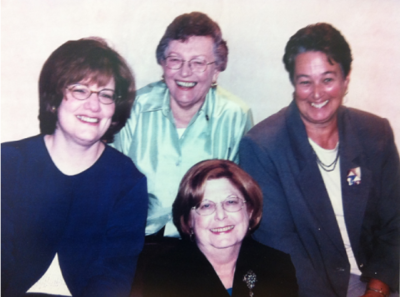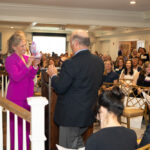Over the next few months, we are excited to share with you the story of how The Second Step began, where we are now, and where we are headed.
In 1987, four women gathered around a kitchen table, their minds focused on more than just sipping coffee. Nancy Douttiel, Lisa Giudice, Margaret Grometstein, and Ellen Schoendorf met while volunteering at a domestic violence crisis center. In an era when domestic violence remained largely unspoken and not well understood, they recognized that escaping an abusive situation was merely the first step on a survivor’s complex journey.
But what happens next?
Tragically, the lack of resources for finding alternative, long-term housing forced many survivors back into unsafe environments.
On one particular day, the women watched as a client, who had been bouncing back and forth between emergency shelters for months, made a heartbreaking choice: to return to her abuser. Faced with the prospect of yet another move, she couldn’t wait for more stable housing.
Recognizing the immense difficulty of leaving a dangerous relationship, the four women, committed to breaking the cycle of abuse, embarked on a journey to build an organization dedicated to supporting survivors on the next step towards independent, sustainable lives. Thus, The Second Step (TSS) was born.

Vision to Reality: Creating The Second Step
On February 29th, 1988, The Second Step was incorporated, but as Lisa Giudice, one of the founders, puts it, “We were a program without a home.” Determined to turn their vision into reality, the four women looked for a place to house The Second Step in the Greater Boston area.
However, the roadblocks were plentiful. Many towns expressed apprehension about an organization like The Second Step coming to their community. Residents worried about increased crime and a negative impact on their neighborhoods. The women faced an uphill battle, dispelling myths and educating people about the true nature of domestic violence. While they searched, they wrote countless proposals to secure funding for The Second Step’s future.
After an initial location fell through, a turning point arrived in 1991 with a call from Newton Mayor Theodore Mann. He offered Newton as a location for The Second Step and assisted in securing a building for the first of The Second Step’s residences. Receiving a generous grant from the Department of Housing and Urban Development (HUD) further propelled their vision forward.
1992 marked a pivotal moment with the official opening of The Second Step’s doors, led by Elisabeth (Liz) Kirsch as the first Executive Director.
Lisa remembers helping Liz set up her office on their first day. She recalls a little boy peeking around a corner into the office, a broad smile on his face. She asked if he was happy, and he responded that he was happy, and that his mom was happy too, “we even had pancakes for lunch!” he exclaimed. In that moment, Lisa knew their perseverance had paid off.
The initial residence, staffed by a dedicated team of three, offered a safe space for eight women and their children. Liz Kirsch remained the Executive Director for fifteen years, driven by the opportunity to expand The Second Step’s services.
Thanks for reading! We can’t wait to share more about The Second Step’s current services in our next blog post.

